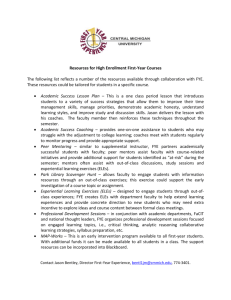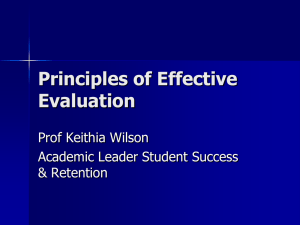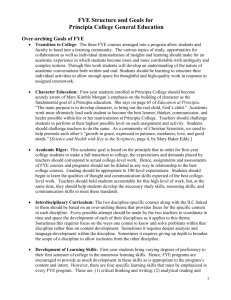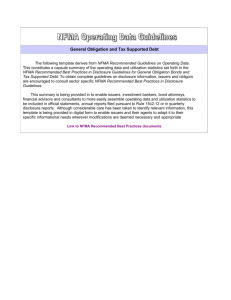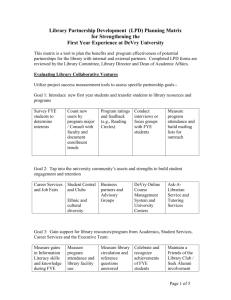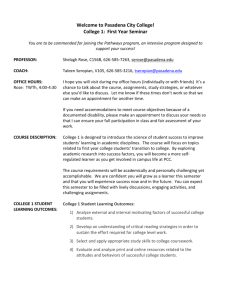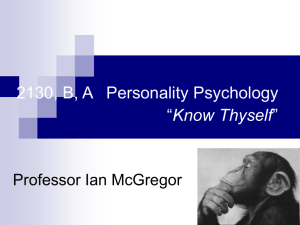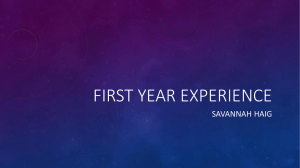TIFpresentationFYE201May2015
advertisement
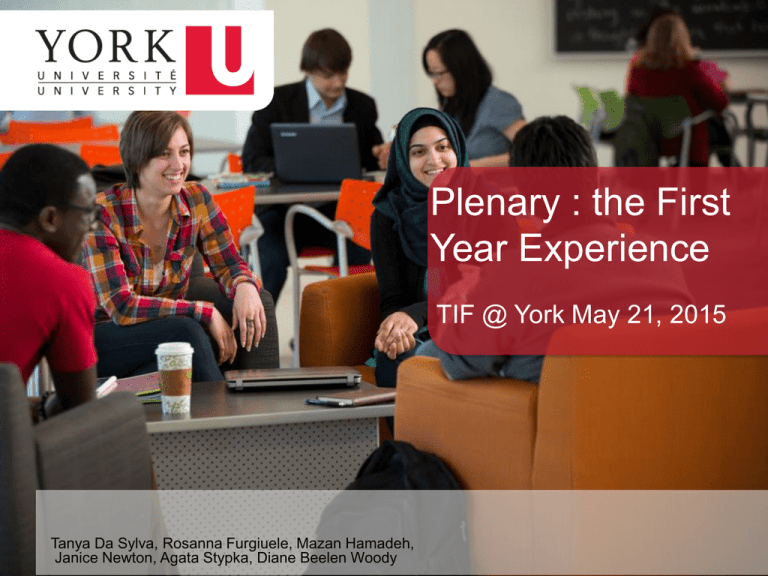
Plenary : the First Year Experience TIF @ York May 21, 2015 Tanya Da Sylva, Rosanna Furgiuele, Mazan Hamadeh, Janice Newton, Agata Stypka, Diane Beelen Woody Highlights from the Dallas 2015 Conference • National Resource Center on the First Year Experience and Students in Transition at the University of South Carolina http://www.sc.edu/fye/index.html • Links to resources on teaching and supporting first year students at http://www.sc.edu/fye/resources/fyr/index.html Conference program • Complete conference program and links to Keynote addresses and to presentations and handouts available at http://www.sc.edu/fye/events/presentation/annual/2015/inde x.html The 34th annual FYE conference 2015 • Over 2000 participants from 17 countries • Plethora of presentations, program that ran for 120 pp. • Co-hosted by York University • Four categories of session: Keynote addresses Current trends in first year experience Research on the first year experience Initiatives that have been instituted and evaluated Panel members and their attachment to FYE • • • • • • Agata Stypka Mazen Hamadeh Janice Newton Rosanna Furgiuele Tanya Da Sylva Diane Woody Big Question #1 • What do the words “Broccoli Curriculum” conjure up? Challenging the Broccoli Curriculum: Designing First Year 2.0 • Keynote address by George L. Mehaffy • Vice President for Academic Leadership and Change • American Association of State Colleges and Universities Re-Imagining the First Year of University • George Mehaffy calls the first year curriculum the broccoli curriculum. • It looks nice, and may be good for you, but nobody wants to eat it. • Students take things that look strange, disconnected from their lives and experiences, but are told that it will be good for them later on. Re-Imagining the First Year of University • In the academic curriculum, we tell students that they must take general education courses but never explain to them what the purpose of general education is. • We leave it to students to make connections between courses, to make for themselves a comprehensive understanding of the educational experience they are undertaking. Where the Broccoli Curriculum has lead us… • Students in the first year fail in large numbers, and given the changing student body, will continue to do so at the same or higher rates • Our institutions have been created as teaching institutions, instead of learning institutions. • Mehaffy’s Big Question: How would things change if we focused on learning, a student-centered approach, instead of teaching, a faculty-centric approach? What does Mehaffy mean by “facultycentric”? • The faculty member is the expert, the center of the experience, the deliverer of the content. • Assumption that every learning experience grows out of a teaching experience. • Assumption that no learning experience can occur without a teacher. What if, asks Mehaffy,…. • …our job in the classroom is not to “teach” as a standalone activity? • but to create the environment which optimizes learning for our students. Coming back to the first year experience: two specific issues flagged by Mehaffy 1. Resources: Universities and Colleges spend the least amount of money on the first two years, and then seem to be startled that those are the years of the greatest loss of students. 2. Curriculum: The curriculum is often irrelevant to the lives of students, who often do not understand why they are required to fulfill general education requirements. So what would Mehaffy do? • How do we go about creating a new design for the first year of university? • What would a completely redesigned first year look like? Four key elements of a re-designed FYE 1. Institutional intentionality 2. Faculty 3. Curriculum 4. Students A Culture that pays attention to FYE • Results of a study : what mattered most about graduation success was not a specific program or special funding but culture: o A campus culture where faculty and staff believed that their role was to help students become successful; o Culture is a critical component of a redesigned first year of university. Final thoughts • We can’t put in place one new strategy, one new program, or one new approach, and hope that will solve the entire problem. It won’t. • We must attack the failed system in a systemic way, seeking radical, transformational reform. • George Mehaffy urges us to ask good, provocative questions that could be a powerful tool in the arsenal of change. It’s a wrap ! 18 Big Question #2: How do we conceptualize "Student Success"? Student Success and Learning • Learning Reconsidered 2 catalyzed a conceptual shift in understanding learning in higher education and in advancing the notion of learning as everyone’s responsibility. That work articulated learning outcomes from a holistic perspective enabling academics, student service personnel, staff and students to see themselves as co-facilitators of learning. • Academic learning and personal development are intertwined reciprocal processes that could just be called learning, and indeed, learning is inherently developmental and personal. • Wiggers & Arnold (2011) pointed out, student success is a complex phenomenon. In many ways we need to accept that it is muddy and messy. Moving towards a learning paradigm and unifying campus culture by: Identifying common educational outcomes Identifying common learning principles and a common language of student success Designing comparable educational materials and artifacts Creating organizational structures that stimulate and sustain crossdivisional partnerships Intentional faculty recruitment, orientation, development, and reward strategies How do we make this university so engaging, interesting, and caring that no one wants to leave? What would happen if we changed the focus of everything we did to developing curiosity in first year students? Supporting learning at York • Learning through academic engagement • Learning through cocurricular engagement Intellectual Social Community /Civic Interpersonal • Learning through community engagement Rogers, M. & Stypka, A. (2013). Partners in Learning. • Learning through cocurricular engagement Big Question # 3: • What comes to mind when you think of GRIT ? GRIT as an acronym • • • • Growth mindset Resilience Intuition/Initiative Tenacity • Current research on the non-cognitive factors (attitudes, values and behaviours) • These occur in tandem with-- and exert considerable influence on --- cognitive development What is Resilience? the ability to become strong, healthy, or successful again after something bad happens the ability of something to return to its original shape after it has been pulled, stretched, pressed, bent, etc. • (Merriam-Webster Dictionary; http://www.merriam-webster.com/dictionary/resilience) NCHA II Data Within the last 12 months have you…. York % ON Reference Group % Felt overwhelmed by all you had to do 89% 90% Felt exhausted (not from physical activity) 86% 87% Felt very sad 68% 70% Felt very lonely 62% 66% Felt overwhelming anxiety 57% 58% Felt things were hopeless 59% 57% Felt overwhelming anger 46% 44% Felt so depressed it was difficult to function 42% 40% Seriously considered suicide 12% 11% Intentionally injured yourself 8% 8% Attempted suicide 2% 2% NCHA II Data Within the last 12 months have any of the following been traumatic or difficult to handle? York % ON Reference Group % Academics 61% 59% Finances 44% 36% Career related issues 40% 36% Sleep difficulties 37% 33% Family problems 37% 32% Intimate relationships 34% 32% NCHA II Data Factors impacting academic performance* York % ON Reference Group % Stress 43% 41% Sleep difficulties 27% 29% Anxiety 27% 30% Internet use/computer games 25% 24% Depression 20% 19% *Academic performance is defined as: received a lower grade on an exam or important project; received a lower grade in the course, received an incomplete or dropped the course; or experienced a significant disruption in thesis, dissertation, research or practicum work. NCHA II Data Have you received information York % on the following topics Are you interested in receiving York % information on the following topics Depression/Anxiety 49% Depression/Anxiety 65% How to help others in distress 25% How to help others in distress 64% Problem use of internet/computer games 14% Problem use of internet/computer games 31% Sleep difficulties 14% Sleep difficulties 64% Stress reduction 55% Stress reduction 75% Suicide prevention 21% Suicide prevention 44% Nutrition 36% Nutrition 69% Physical activity 42% Physical activity 62% Health Promotion at York Mental Health Peer Team…outreach throughout the year: Tabling Stress busters Regular blogging Walkabouts (http://healthed.scld.yorku.ca/about-us/the-peer-team/mentalhealth-team/) Available to students, staff & faculty SafeTALK (https://www.livingworks.net/programs/safetalk/) Suicide alertness workshop ASIST: Applied Suicide Intervention Skills Training (https://www.livingworks.net/programs/asist/) Teaches effective intervention skills Builds suicide prevention networks in community More Feet on the Ground bilingual online educational tool… with a broad overview of mental health (http://mhw.info.yorku.ca/training/) Mental Health 101 (http://mhw.info.yorku.ca/training/) Available to students, staff & faculty CDS: Personal Counselling (http://cds.info.yorku.ca/) Mental Health Disability Services (http://mhds.info.yorku.ca/) Healthy Student Initiative (Paul Ritvo) (http://healthystudentinitiative.com/) Others: Active Minds (https://www.facebook.com/activeminds.yorku) Jack Project (http://www.jack.org/) • Big Question #4: • How can instructors in the classroom support student success, curiosity, GRIT and resilience? Classroom practices profiled at the FYE conference “First to go” CREATE Sneaky Strategies Your questions/comments? • Remembering your own First Year Experience • Relating this to York’s commitment to FYE….. • Opportunities to work on the FYE at York….
